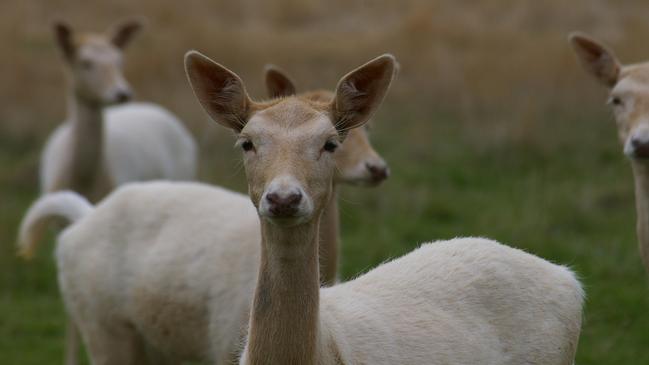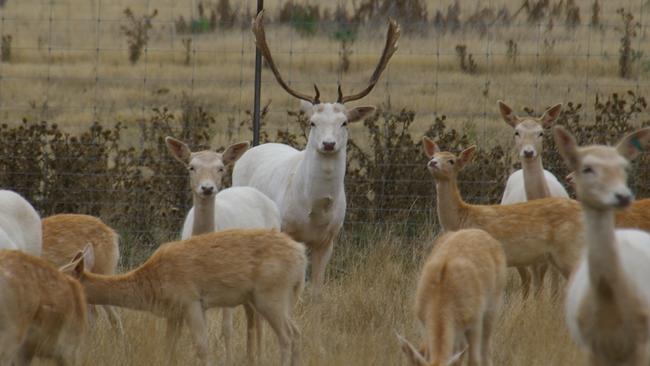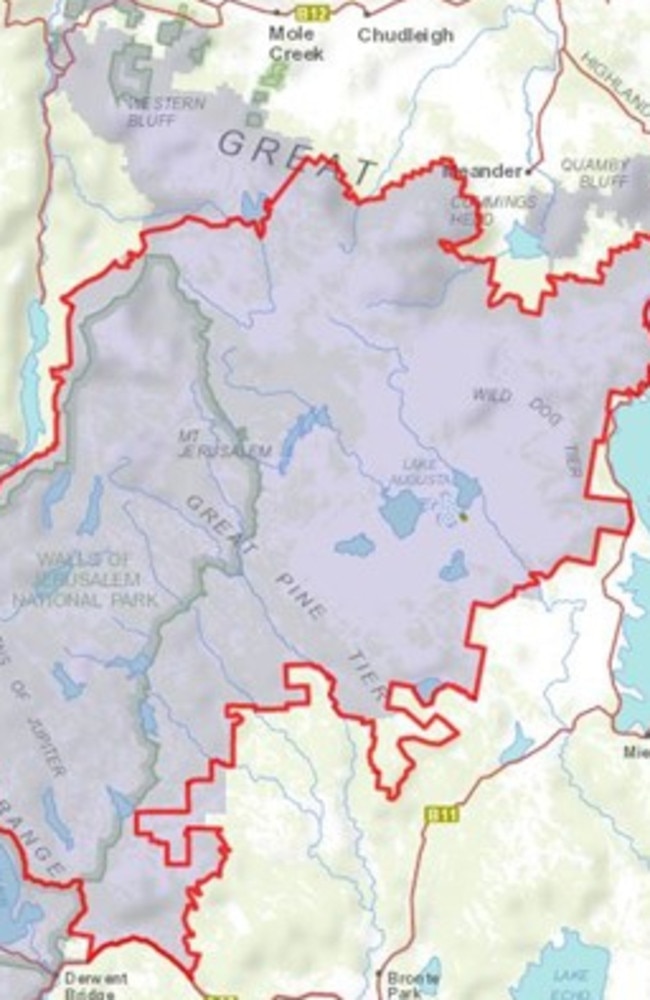Lenah Game Meats’ John Kelly on Tasmania Parks and Wildlife Service’s TWWHA Deer Control Project
A Tasmanian game meats manufacturer says the government “sat on its hands” over the growing feral deer population, and a looming cull of up to 300 animals was “the only option”. LATEST DEER DRAMA >
Tasmania
Don't miss out on the headlines from Tasmania. Followed categories will be added to My News.
A LEADING Tasmanian game meats manufacturer says the government “sat on its hands for too long” over the growing feral deer population, and a looming cull of up to 300 animals in the state’s national parks was “the only option”.
Launceston’s Lenah Game Meats owner John Kelly doesn’t necessarily agree with Tasmanian Parks and Wildlife Service’s Deer Control Project, but says the recent passing of a trial to process and export feral fallow deer commercially in the state was a “huge win”.
Off the back of a feasibility study on the commercialisation of wild fallow deer meat, the Tasmanian State Government rolled out the commercial trial in April. It will conclude in April 2025.
The win, Mr Kelly says, is a potential $3 million per year opportunity in the game meats market.

“It means we don’t have to import venison from the mainland and we can export our superior product. I’ve been lobbying the government for years on it,” he said.
“Opening up the deer meat industry here means jobs are created, with $3 million extra tipped into the Tasmanian economy.”
Despite the victory for venison, Mr Kelly says the animal should not be relied upon as a “resource”. He says he wouldn’t argue a decision to eradicate the introduced feral species.
Mr Kelly criticised the state government’s handling of the population, one he said became “completely out of control.”
“The government sat on its hands for too long and relied too long on only one tool to control the deer population – recreational shooters”.
“There’s just no way the deer population could be controlled, particularly in remote, inaccessible parts of those national parks. The cull is now the only option we have.”
From a manufacturing standpoint, Mr Kelly said the cull would render the meat “useless from the types of shots fired from the helicopter” and “would not be a product we would use in terms of food quality”.
It comes as recreational shooters took aim at the program last week, saying carcasses would be left to rot rather than “filling our freezers and feeding our families”.
The cull starts in May, predominantly in The Walls of Jerusalem National Park in Tasmania’s Central Highlands. That park will shut for the operation.
Three other parks – the Central Plateau Conservation Area, the Meander Conservation Area and the Great Western Tiers Conservation Area – will also be partly closed from May 1 to June 4.
Mr Kelly has been an industry leader in producing game meats for three decades.
His company was the first to process and market wallaby meat to restaurants and supermarkets, including Woolworths.
The company even produces its own ‘Wugg’ boots, made from wallaby fur.
His products are on the menus of some of the most highly-acclaimed restaurants in the state.
Shots fired: Deer kill ‘poorly planned, inhumane and unacceptable’
April 14: The Tasmanian arm of Australian political party Shooters, Farmers and Fishers has flagged “concerns” about Tasmanian Parks and Wildlife Service’s looming deer cull operation in the Central Highlands, saying the killing could be considered as “inhumane”.
Parks’ Deer Control Project starts in May and aims to kill up to 300 feral fallow deer – an introduced species.

The Department of Natural Resources and Environment on Thursday rejected the claims.
“Animal welfare is a primary objective of the planning for this aerial control program and all shooting will be undertaken by trained markspersons, overseen by a qualified veterinarian, using high-calibre, semiautomatic firearms and ammunition, available to animal control professionals,” a department spokesperson said.
Tasmania’s Shooters, Fishers and Farmers spokesman Adrian Pickin said the hunting and wider community had concerns around the use of semiautomatic rifles, which he said shooters in helicopters will use to kill the deer.
“By the government’s own admission, the national average aerial shots required for an effective kill is four to five shots per animal and in some cases significantly more – it’s unacceptable,” Mr Pickin said.
“Ground shooting is much more humane and ethical, as is bow hunting – had the government not banned it.
“The party doesn’t support deer to be shot multiple times and carcasses left to rot.”
Mr Pickin said aerial culls were “indiscriminate” and that it could result in the killing of “non-target species”.
He claimed the government had “lacked transparency” and said the plan was “poorly developed”.
“It should be revisited and alternative methods explored with greater stakeholder input,” Mr Pickin said.
The Tasmania Parks and Wildlife Service said it had consulted with the Chief Veterinary Officer in relation to its obligations under the Animal Health Act.
“This program is being conducted in a remote and isolated part of the Walls of Jerusalem National Park and Central Plateau Conservation Area, part of the Tasmanian Wilderness World Heritage Area, and delivers on the Tasmanian Wild Fallow Deer Management Plan for zone 3, where “no deer” is the broad management objective,” the NRE said.
“Aerial control is a practical way to rapidly reduce the estimated population of 300 deer and it is not always practical to remove deceased animals from remote areas without causing environmental harm or posing a safety risk.”
Deer bodies will be left to rot: shooters
April 12: Recreational shooters have taken aim at Tasmanian Parks and Wildlife Service’s plans to conduct an aerial cull of up to 300 feral deer, saying the carcasses will be left to rot out in the open rather than “letting people feed their families and fill their freezers”.
A team of government-employed sharp shooters in helicopters will undertake the cull in May, in conjunction with the temporary closure of one of the state’s busiest national parks – The Walls of Jerusalem in Tasmania’s Central Highlands.
Three other parks – the Central Plateau Conservation Area, the Meander Conservation Area and the Great Western Tiers Conservation Area – will be partly closed during the cull from May 1 to June 4.

A follow-up cull will take place in May 2024.
The trained gunmen will use thermal heat-seeking technology to shoot the deer.
In December last year, Tasmanian Parks and Wildlife Service received a funding boost of $440,000 from the federal government to launch the pilot program, which aims to eradicate the feral deer in the state’s national parks.

While the recreational shooters are up in arms over not being able to “have first crack”, Parks and Wildlife say “limited ground shooting” will be undertaken by “highly experienced volunteers provided by the Tasmanian branches of the Australian Deer Association and the Sporting Shooters Association of Australia”.
But some recreational shooters have taken to social media to slam the program, saying carcasses will be left to rot instead of providing wild game for families to freeze and feast on throughout the year.
Andrew Towns wrote: “Not only could the government save money by letting rec hunters on foot have first crack before sending in the choppers, selling permits or a tag system could have made a lot of money – and the deer wouldn’t be left to rot on the ground.”
Zilla Brown suggested: “How about an open season with no tag restrictions on people filling their freezers? I suppose the government would rather do pest control than allow the population to eat for free. Why is there restrictions on an introduced species? Isn’t on rabbits – funny that.

“They would rather let deer be shot and rot than let people feed their families on some nice wild meat for free,” she added.
Greg Mc said: “Open it up to hunters and use the resource instead of letting carcass rot in the bush … Big well dun (sic) parks once again – not.”
In relation to the carcasses, The Tasmanian Wilderness World Heritage Area TWWHA Deer Control Project outlines that “all deer shot will be left in situ unless they pose a social, health or environmental risk.
“Carcasses will be removed from watercourses, near reserve and hydro infrastructure (walking tracks, huts, campgrounds) and close to roads and vehicle tracks, all other carcasses will be left to decompose.”
Parks and Wildlife say wild Fallow Deer are a threat to the natural environment of the TWWHA.
“Deer erode and damage soils and waterways, trample sensitive plant communities, browse vegetation at a level above native animals, as well as eating different plants.
“In large numbers, deer can substantially change the environment. Fallow Deer can also be spread animal and plant diseases. If deer are allowed to increase in number and spread in Tasmania’s parks and reserves significant environmental damage is likely to occur.”
Deer were first introduced in Tasmania in 1836. According to Parks and Wildlife, numbers
remained relatively low until the 1970s. Since the 1970s, Fallow Deer have increased at a compounding rate of 11 per cent per year.





